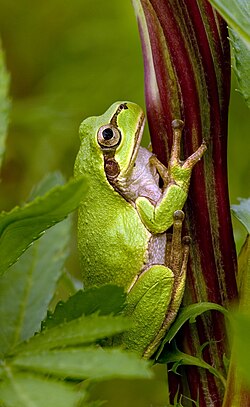| Binomial name and author | Common name |
|---|
|
| Dryophytes andersonii(Baird, 1854) | Pine Barrens treefrog |
| Dryophytes aboricola(Taylor, 1941) | arboreal treefrog |
| Dryophytes arenicolor(Cope, 1866) | canyon tree frog |
| Dryophytes avivocus(Viosca, 1928) | bird-voiced treefrog |
| Dryophytes bocourti(Mocquard, 1899) | Bocourt's tree frog |
| Dryophytes chrysoscelis(Cope, 1880) | Cope's gray treefrog |
| Dryophytes cinereus(Schneider, 1799) | American green tree frog |
| Dryophytes euphorbiaceus(Günther, 1858) | southern highland tree frog |
| Dryophytes eximius(Baird, 1854) | mountain treefrog |
| Dryophytes femoralis(Daudin, 1800) | pine woods treefrog |
| Dryophytes flaviventris(Borzée & Min, 2019) | yellow-bellied treefrog |
| Dryophytes gratiosus(LeConte, 1856) | barking treefrog |
| Dryophytes immaculatus(Boettger, 1888) | spotless tree toad |
| Dryophytes japonicus(Günther, 1859) | Japanese treefrog |
| Dryophytes leopardus Shimada & Matsui, 2025 | Eastern Japanese treefrog | |
| Dryophytes plicatus(Brocchi, 1877) | ridged tree frog |
| Dryophytes squirellus(Daudin, 1800) | squirrel treefrog |
| Dryophytes suweonensis(Kuramoto, 1980) | Suweon treefrog |
| Dryophytes versicolor(LeConte, 1825) | gray treefrog |
| Dryophytes walkeri(Stuart, 1954) | Walker's tree frog |
| Dryophytes wrightorum(Taylor, 1939) | Wright's mountain tree frog |




